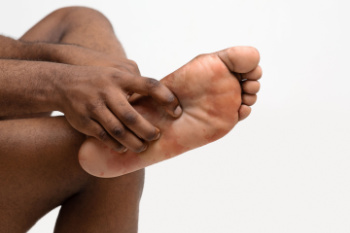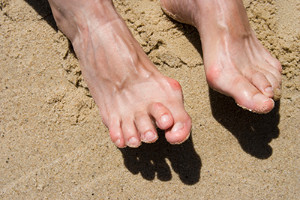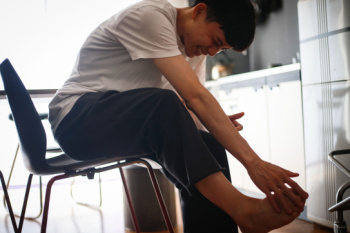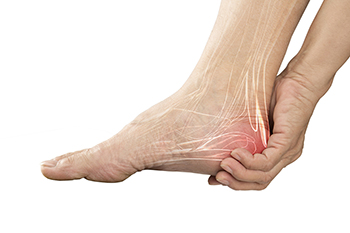Items filtered by date: September 2025
Plantar Fasciitis and Why It Causes Foot Pain

Plantar fasciitis is one of the most common reasons people experience heel pain. It develops when the thick band of tissue that connects the heel to the toes becomes irritated or inflamed. Many people notice sharp pain in the morning with their first steps, which may ease as the day goes on, but often returns after long periods of standing or activity. Risk factors include wearing unsupportive shoes, spending long hours on hard surfaces, and having flat feet or very high arches. Stretching exercises, wearing proper footwear, and sometimes custom orthotics can help relieve the strain on the plantar fascia. Left untreated, the discomfort can become persistent and interfere with daily activities. If heel pain is affecting your mobility, it is suggested that you visit a podiatrist to discuss appropriate treatment options.
Plantar fasciitis is a common foot condition that is often caused by a strain injury. If you are experiencing heel pain or symptoms of plantar fasciitis, contact one of our podiatrists from Highlands Foot and Ankle. Our doctor can provide the care you need to keep you pain-free and on your feet.
What Is Plantar Fasciitis?
Plantar fasciitis is one of the most common causes of heel pain. The plantar fascia is a ligament that connects your heel to the front of your foot. When this ligament becomes inflamed, plantar fasciitis is the result. If you have plantar fasciitis you will have a stabbing pain that usually occurs with your first steps in the morning. As the day progresses and you walk around more, this pain will start to disappear, but it will return after long periods of standing or sitting.
What Causes Plantar Fasciitis?
- Excessive running
- Having high arches in your feet
- Other foot issues such as flat feet
- Pregnancy (due to the sudden weight gain)
- Being on your feet very often
There are some risk factors that may make you more likely to develop plantar fasciitis compared to others. The condition most commonly affects adults between the ages of 40 and 60. It also tends to affect people who are obese because the extra pounds result in extra stress being placed on the plantar fascia.
Prevention
- Take good care of your feet – Wear shoes that have good arch support and heel cushioning.
- Maintain a healthy weight
- If you are a runner, alternate running with other sports that won’t cause heel pain
There are a variety of treatment options available for plantar fasciitis along with the pain that accompanies it. Additionally, physical therapy is a very important component in the treatment process. It is important that you meet with your podiatrist to determine which treatment option is best for you.
If you have any questions, please feel free to contact our office located in Waco, TX . We offer the newest diagnostic and treatment technologies for all your foot care needs.
Common Reasons for the Development of a Hammertoe
 Hammertoes are considered to be a foot deformity, commonly affecting the second, third or fourth toes. This condition can cause the toe to bend downward, resembling a hammer. Hammertoes can be brought on by a muscle imbalance in the feet, wearing tightly fitted shoes, and nerve damage, which is often linked to complications with diabetes. Hereditary reasons pertaining to the overall structure of the legs and feet can also play a role in the development of a hammertoe. To help treat this condition, custom orthotics are often prescribed to improve the structure and function of the affected toe. For a proper diagnosis and advised treatment plan, please consult with a podiatrist.
Hammertoes are considered to be a foot deformity, commonly affecting the second, third or fourth toes. This condition can cause the toe to bend downward, resembling a hammer. Hammertoes can be brought on by a muscle imbalance in the feet, wearing tightly fitted shoes, and nerve damage, which is often linked to complications with diabetes. Hereditary reasons pertaining to the overall structure of the legs and feet can also play a role in the development of a hammertoe. To help treat this condition, custom orthotics are often prescribed to improve the structure and function of the affected toe. For a proper diagnosis and advised treatment plan, please consult with a podiatrist.
Hammertoes can be a painful condition to live with. For more information, contact one of our podiatrists of Highlands Foot and Ankle. Our doctor will answer any of your foot- and ankle-related questions.
Hammertoe
Hammertoe is a foot deformity that occurs due to an imbalance in the muscles, tendons, or ligaments that normally hold the toe straight. It can be caused by the type of shoes you wear, your foot structure, trauma, and certain disease processes.
Symptoms
- Painful and/or difficult toe movement
- Swelling
- Joint stiffness
- Calluses/Corns
- Physical deformity
Risk Factors
- Age – The risk of hammertoe increases with age
- Sex – Women are more likely to have hammertoe compared to men
- Toe Length – You are more likely to develop hammertoe if your second toe is longer than your big toe
- Certain Diseases – Arthritis and diabetes may make you more likely to develop hammertoe
Treatment
If you have hammertoe, you should change into a more comfortable shoe that provides enough room for your toes. Exercises such as picking up marbles may strengthen and stretch your toe muscles. Nevertheless, it is important to seek assistance from a podiatrist in order to determine the severity of your hammertoe and see which treatment option will work best for you.
If you have any questions, please feel free to contact our office located in Waco, TX . We offer the newest diagnostic and treatment technologies for all your foot care needs.
Stretches to Improve Foot Health

Strong and flexible feet are essential for daily movement and overall mobility. Simple foot stretches can keep your feet healthy and reduce the risk of injury. A calf stretch is done by standing with your hands against a wall, one leg behind the other, and leaning forward to gently stretch the back calf muscle. An ankle stretch helps by rotating the ankle slowly in circles to improve flexibility and strength. Additionally, a foot arch stretch can be done by sitting, placing one foot over the opposite knee, and gently pulling back the toes to stretch the arch. If you have foot pain, it is suggested that you promptly consult a podiatrist who can treat various foot conditions, and guide you on specific foot strengthening stretches.
Stretching the feet is a great way to prevent injuries. If you have any concerns with your feet consult with one of our podiatrists from Highlands Foot and Ankle. Our doctor will assess your condition and provide you with quality foot and ankle treatment.
Stretching the Feet
Stretching the muscles in the foot is an important part in any physical activity. Feet that are tight can lead to less flexibility and make you more prone to injury. One of the most common forms of foot pain, plantar fasciitis, can be stretched out to help ease the pain. Stretching can not only ease pain from plantar fasciitis but also prevent it as well. However, it is important to see a podiatrist first if stretching is right for you. Podiatrists can also recommend other ways to stretch your feet. Once you know whether stretching is right for you, here are some excellent stretches you can do.
- Using a foam roller or any cylindrical object (a water bottle or soda can will do), roll the object under your foot back and forth. You should also exert pressure on the object. Be sure to do this to both feet for a minute. Do this exercise three times each.
- Similar to the previous one, take a ball, such as a tennis ball, and roll it under your foot while seated and exert pressure on it.
- Grab a resistance band or towel and take a seat. If you are using a towel, fold it length wise. Next put either one between the ball of your foot and heel and pull with both hands on each side towards you. Hold this for 15 seconds and then switch feet. Do this three times for each foot.
- Finally hold your big toe while crossing one leg over the other. Pull the toe towards you and hold for 15 seconds. Once again do this three times per foot.
It is best to go easy when first stretching your foot and work your way up. If your foot starts hurting, stop exercising and ice and rest the foot. It is advised to then see a podiatrist for help.
If you have any questions please contact our office located in Waco, TX . We offer the newest diagnostic and treatment technologies for all your foot and ankle needs.
Plantar Warts Can Be Treated!
When Foot Pain Strikes Suddenly

Gout is a form of arthritis that often affects the joints in the feet, particularly the big toe. Symptoms typically appear suddenly, often at night, and include intense pain, swelling, redness, and warmth in the affected joint. The area may appear shiny and feel extremely tender, even to the touch of a bedsheet. Gout is caused by a buildup of uric acid in the blood, which forms sharp crystals in the joints. Common triggers include diets high in red meat or seafood, excessive alcohol, dehydration, and genetic factors. A podiatrist can diagnose gout through a physical exam, a review of symptoms, and possibly blood tests or joint fluid analysis. Treatment may involve anti-inflammatory medications, dietary changes, lifestyle advice, and, in some cases, medication to reduce uric acid levels. A podiatrist can also help manage recurring flare-ups and long-term joint health. If you are experiencing these symptoms, it is suggested that you schedule an appointment with a podiatrist for appropriate relief and treatment solutions.
Gout is a foot condition that requires certain treatment and care. If you are seeking treatment, contact one of our podiatrists from Highlands Foot and Ankle. Our doctor will treat your foot and ankle needs.
What Is Gout?
Gout is a type of arthritis caused by a buildup of uric acid in the bloodstream. It often develops in the foot, especially the big toe area, although it can manifest in other parts of the body as well. Gout can make walking and standing very painful and is especially common in diabetics and the obese.
People typically get gout because of a poor diet. Genetic predisposition is also a factor. The children of parents who have had gout frequently have a chance of developing it themselves.
Gout can easily be identified by redness and inflammation of the big toe and the surrounding areas of the foot. Other symptoms include extreme fatigue, joint pain, and running high fevers. Sometimes corticosteroid drugs can be prescribed to treat gout, but the best way to combat this disease is to get more exercise and eat a better diet.
If you have any questions, please feel free to contact our office located in Waco, TX . We offer the newest diagnostic and treatment technologies for all your foot care needs.
Understanding Heel Pain in Seniors

Heel pain is a common complaint among seniors and can be caused by plantar fasciitis, heel spurs, and arthritis. Plantar fasciitis often results in sharp pain in the heel, especially in the morning, caused by inflammation of the tissue along the bottom of the foot. Heel spurs are bony growths that can cause stabbing pain with walking or standing. Arthritis in the heel joint may lead to aching, stiffness, and swelling, making daily activities uncomfortable. The heel may look swollen or feel warm and tender to the touch. A podiatrist can help diagnose the specific cause through a physical exam and imaging, such as X-rays or ultrasound. Treatment options include stretching exercises, supportive footwear, or anti-inflammatory medications. In some cases, more advanced treatments may be necessary. For proper diagnosis, effective relief, and a plan to improve your mobility, it is suggested that you make an appointment with a podiatrist.
Many people suffer from bouts of heel pain. For more information, contact one of our podiatrists of Highlands Foot and Ankle. Our doctor can provide the care you need to keep you pain-free and on your feet.
Causes of Heel Pain
Heel pain is often associated with plantar fasciitis. The plantar fascia is a band of tissues that extends along the bottom of the foot. A rip or tear in this ligament can cause inflammation of the tissue.
Achilles tendonitis is another cause of heel pain. Inflammation of the Achilles tendon will cause pain from fractures and muscle tearing. Lack of flexibility is also another symptom.
Heel spurs are another cause of pain. When the tissues of the plantar fascia undergo a great deal of stress, it can lead to ligament separation from the heel bone, causing heel spurs.
Why Might Heel Pain Occur?
- Wearing ill-fitting shoes
- Wearing non-supportive shoes
- Weight change
- Excessive running
Treatments
Heel pain should be treated as soon as possible for immediate results. Keeping your feet in a stress-free environment will help. If you suffer from Achilles tendonitis or plantar fasciitis, applying ice will reduce the swelling. Stretching before an exercise like running will help the muscles. Using all these tips will help make heel pain a condition of the past.
If you have any questions, please feel free to contact our office located in Waco, TX . We offer the newest diagnostic and treatment technologies for all your foot care needs.

